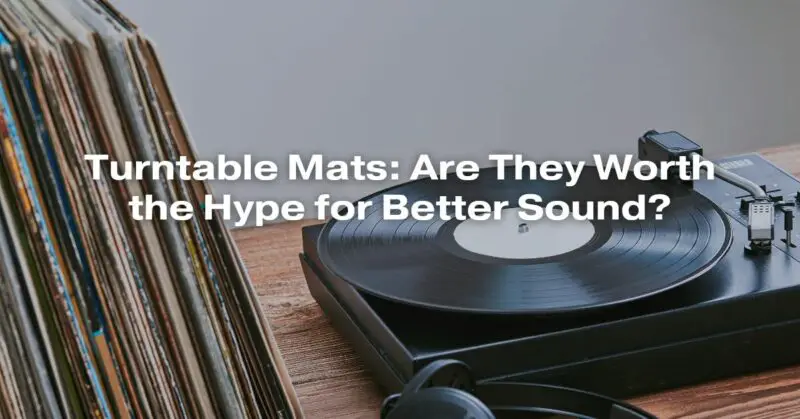Vinyl records have made a remarkable comeback in recent years, attracting both audiophiles and music enthusiasts seeking a tangible and authentic way to enjoy their favorite tunes. Analog enthusiasts often argue that vinyl records offer a warmer and more immersive listening experience compared to digital formats. However, the sound quality of a vinyl record is not solely dependent on the vinyl itself; it’s also influenced by various components of a turntable setup. One such component that has gained attention in recent times is the turntable mat. But are turntable mats really worth the hype for achieving better sound quality? In this article, we’ll explore the purpose of turntable mats, how they work, and whether they can genuinely enhance your vinyl listening experience.
Understanding the Role of Turntable Mats
A turntable mat is a relatively simple yet crucial part of any vinyl playback system. It’s the soft, cushion-like material that sits on top of the platter of a turntable. Its primary function is to support the vinyl record and improve the overall performance of the turntable. Turntable mats are available in various materials, including rubber, cork, felt, leather, and even acrylic. Each material can have a different impact on sound quality, but their core function remains the same.
Reducing Vibrations and Resonance
One of the main purposes of a turntable mat is to reduce vibrations and resonance. When a vinyl record spins on a turntable, it encounters various vibrations, both from the motor and external sources. These vibrations can negatively affect the stylus’s tracking ability and, consequently, the sound quality. Turntable mats act as a barrier, absorbing and dissipating these vibrations before they reach the stylus. This reduction in unwanted noise and resonance can result in a cleaner and more accurate playback of your records.
Protecting Records
Turntable mats also serve a protective role by acting as a buffer between the vinyl record and the hard platter underneath. Without a mat, the record’s grooves would come into direct contact with the platter, increasing the risk of scratches and other forms of damage. The mat’s soft surface helps prevent this damage and prolongs the lifespan of your vinyl records.
Improving Grip
Another benefit of using a turntable mat is improved grip. Some mats have anti-slip properties that help the vinyl record adhere more securely to the platter. This improved grip can reduce slippage and ensure a stable rotation, which is essential for accurate tracking and playback.
Types of Turntable Mats
As mentioned earlier, turntable mats come in various materials, each with its own unique characteristics and sound properties. Here are some common types:
- Rubber Mats: Rubber mats are known for their excellent vibration-dampening properties. They provide a good balance between damping vibrations and maintaining contact with the record.
- Cork Mats: Cork mats are lightweight and known for their natural and warm sound. They offer good vibration reduction and are favored by many audiophiles for their ability to add warmth to the sound.
- Felt Mats: Felt mats are one of the most common types and are known for their affordability. They provide decent dampening of vibrations and are suitable for general use.
- Leather Mats: Leather mats are often considered a luxury option. They are known for their durability and can provide a neutral sound profile.
- Acrylic Mats: Acrylic mats are transparent and can add a modern aesthetic to your turntable. They are known for their transparency in sound reproduction and are often chosen for their minimal coloration of sound.
Do Turntable Mats Really Make a Difference?
The answer to whether turntable mats are worth the hype for better sound quality largely depends on your personal preferences, the quality of your turntable, and your listening environment. Here are some factors to consider:
- Turntable Quality: If you have a high-quality turntable with excellent isolation and a well-designed platter, the difference made by a turntable mat may be less noticeable compared to a budget turntable.
- Listening Environment: Your room’s acoustics and the quality of your audio system play a significant role in how much you can perceive the benefits of a turntable mat. In a well-treated listening room with high-end equipment, you might notice more significant improvements.
- Material Choice: The material of the turntable mat matters. Different materials can impart subtle tonal characteristics to the sound. Experimenting with different mats may help you find the one that suits your taste best.
- Personal Preference: Ultimately, the decision comes down to personal preference. Some audiophiles swear by turntable mats and believe they are essential for the best sound quality, while others find the difference to be minimal.
Conclusion
Turntable mats can certainly play a role in improving the sound quality of your vinyl records by reducing vibrations, protecting your records, and providing better grip. However, their impact on sound quality may vary depending on your turntable, listening environment, and personal preferences. If you’re an audiophile or a serious vinyl enthusiast, experimenting with different turntable mats can be an enjoyable way to fine-tune your setup and find the sound signature that resonates with you. Ultimately, whether turntable mats are worth the hype for better sound is a subjective judgment, but they undeniably contribute to the overall vinyl listening experience.


